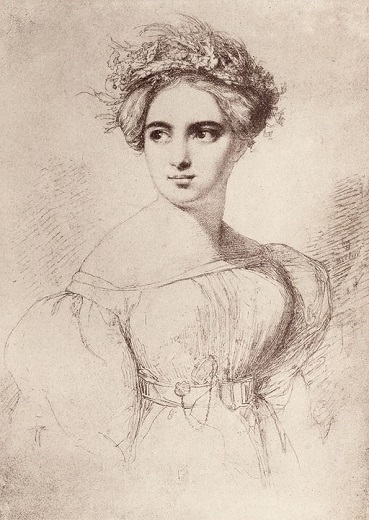
This time, I’d like to write about the ranking of all the pieces in Songs Without Words by difficulty.
This is the second time I’m writing about Mendelssohn. In my previous post, I mainly discussed Mendelssohn himself and the concept of Songs Without Words. You can find that post here.
Once again, I’ll be focusing on Songs Without Words, but this time, I’ll also touch on Mendelssohn’s older sister, Fanny, who had a significant connection to Mendelssohn and Songs Without Words. I will then rank all the pieces by difficulty.
■ 目次
About Mendelssohn

I’ve written about Mendelssohn (Felix) before, but I’d like to add some supplementary details.
Felix, who was born into a Jewish family, was one of four siblings: his older sister Fanny, himself, his younger sister Rebecca, and his younger brother Paul. The four of them grew up in a privileged environment, born into a wealthy family with parents who were highly dedicated to their children’s education. They received not only excellent musical training but also a well-rounded education in other fields.
Felix’s full name is remarkably long: Jakob Ludwig Felix Mendelssohn Bartholdy.
There’s a reason for this long name. “Mendelssohn” is the family surname, but “Bartholdy” is also a surname.
The reason Felix had two surnames is tied to the family’s conversion from Judaism to Christianity. During that era, being Jewish could result in persecution.
While this may not resonate strongly with us today, the surname “Mendelssohn” was easily recognizable as Jewish. Therefore, when the family converted to Christianity, they adopted the non-Jewish surname “Bartholdy.”
Although the family likely took pride in their Jewish heritage and were reluctant to change their name, Felix’s parents decided to take this step as a precaution to protect their children from potential persecution.
However, Felix ultimately refused to abandon the name Mendelssohn. As a result, he used both names—“Mendelssohn” and “Bartholdy”—resulting in a double surname.
Even after converting to Christianity, persecution for being Jewish persisted. Felix’s family still faced challenges and discrimination because of their heritage.
On the Relationship with His Sister Fanny

Felix and his sister Fanny studied under the same teacher and were raised in the same environment, so it can be assumed that the influences they received were nearly identical. Fanny seemed to be an incredibly talented woman, to the extent that their father reportedly felt that Fanny might have even more musical talent than Felix.
However, since it was a difficult era for women to succeed as composers, her father did not support her pursuing a career as a composer. As a result, Felix sometimes published Fanny’s works under his own name.
Later, Fanny got married. Her husband recognized and appreciated her talent, and actively encouraged her to compose and conduct. With her husband’s support, Fanny became active as a composer and conductor, just like Felix.
I have accompanied performances of songs composed by Fanny. I played two of her works, and they were so similar to Felix’s compositions that I would not have questioned it if they had been attributed to him.
What do you think? Both pieces are beautiful, aren’t they?
Fanny’s compositions were so excellent that they were published under Felix’s name without raising any doubts.
Was it the sister imitating her brother, the brother imitating his sister, or neither? Perhaps it was simply that they received the same education and grew up in the same environment, leading to this similarity without them even realizing it. I got the impression that the atmosphere of their works as a whole was remarkably alike.
Fanny and Felix understood each other deeply. Even after her marriage, Fanny cared about her brother, and her diary reportedly contained mentions of him. There might have been a mysterious connection between this brother and sister—a sense of understanding that went beyond logic or words.
Although Fanny led a fulfilling life, she passed away suddenly from a stroke in 1847 at the age of 41. Felix was deeply shocked. It’s only natural—after all, the sister who understood him best had passed away.
Following his sister in death, Felix himself passed away six months later, also from a stroke, at the young age of 38.
As I previously wrote, Felix had a tremendous impact on the world of music through his rediscovery of Bach, the establishment of music academies, and the improvement of orchestral performance standards. It’s astounding that he accomplished all of this by the age of 38. One wonders what could have been if he had lived longer. His early death is truly regrettable.
How Many Pieces Are in the “Songs Without Words” Collection?
For an explanation of what Songs Without Words are, please refer to this previous post.
It is said that the idea for Songs Without Words may have originally come from Fanny. She truly was a talented woman! Much about her remains unknown, but as research progresses, more will likely come to light.
The Songs Without Words collection consists of 48 pieces, divided into 8 volumes (6 pieces per volume).
1st Volume Op. 19 (1832)
2nd Volume Op. 30 (1835)
3rd Volume Op. 38 (1837)
4th Volume Op. 53 (1841)
5th Volume Op. 62 (1844)
6th Volume Op. 67 (1845)
7th Volume Op. 85 (1851)
8th Volume Op. 102 (1868)
Many of the pieces in this collection lack precise composition dates, but the earliest is believed to be Op. 19-4, titled “Confidence,” composed in 1829.
Mendelssohn was born in 1809 and passed away in 1847, so this collection was not written over a short period but rather represents works he continued to write from his twenties onward.
As you can see from the publication dates, the first six volumes were published during his lifetime, while the 7th and 8th volumes were released posthumously. In other words, they are considered his final works.
While the pieces in this collection have titles, very few were assigned by Mendelssohn himself. Most were reportedly added by the publishers upon release.
The titles Mendelssohn personally assigned include the three Venetian Boat Songs, Duet, and Folk Song—a total of five pieces.
Difficulty Ranking of “Songs Without Words”
For the difficulty of Songs Without Words, I wrote about it previously, so this time I would like to write about the ranking of all the pieces by difficulty.The overall difficulty of this collection doesn’t seem to vary significantly, but within that, I’ve tried to rank them based on what I find easier or harder to play.
★ 6 “Venetian Boat Song” (Venetian Gondola Song), Op. 19-6
9 “Consolation”, Op. 30-3
12 “Venetian Boat Song” (Venetian Gondola Song), Op. 30-6
48 “Faith”, Op. 102-6
★★ 2 “Regrets”, Op. 19-2
4 “Confidence”, Op. 19-4
22 “Sadness of Soul”, Op. 53-4
45 “Tarantella”, Op. 102-3
★★★ 1 “Sweet Remembrance”, Op. 19-1
13 “The Evening Star”, Op. 38-1
16 “Hope”, Op. 38-4
25 “May Breezes”, Op. 62-1
27 “Funeral March” (Trauermarsch), Op. 62-3
33 “Song of the Pilgrim”, Op. 67-3
35 “The Shepherd’s Complaint”, Op. 67-5
37 “Reverie”, Op. 85-1
41 “The Return”, Op. 85-5
44 “Retrospection”, Op. 102-2
★★★★ 7 “Contemplation”, Op. 30-1
14 “Lost Happiness”, Op. 38-2
19 “On the Seashore”, Op. 53-1
20 “Clouds”, Op. 53-2
28 “Morning Song”, Op. 62-4
29 “Venetian Boat Song” (Venetian Gondola Song), Op. 62-5
30 “Spring Song” (Frühlingslied), Op. 62-6
36 “Lullaby”, Op. 67-6
40 “Elegy”, Op. 85-4
46 “Sighing Wind”, Op. 102-4
47 “Happiness” (Kinderstück), Op. 102-5
★★★★★ 15 “The Poet’s Harp”, Op. 38-3
17 “Passion”, Op. 38-5
18 “Duet” (Duetto), Op. 38-6
23 “Folk Song” (Volkslied), Op. 53-5
31 “Meditation”, Op. 67-1
34 “Spinning Song” (The Bee’s Wedding), Op. 67-4
39 “Delirium”, Op. 85-3
42 “Song of the Traveler”, Op. 85-6
43 “Homeless”, Op. 102-1
★★★★★★ 3 “Hunting Song” (Jägerlied), Op. 19-3
8 “Unrest”, Op. 30-2
10 “The Wanderer”, Op. 30-4
11 “The Brook”, Op. 30-5
26 “The Departure”, Op. 62-2
32 “Lost Illusions”, Op. 67-2
38 “Adieu”, Op. 85-2
★★★★★★★ 5 “Restlessness”, Op. 19-5
21 “Agitation”, Op. 53-3
24 “Flight”, Op. 53-6
Generally well-known pieces are written in red text.
This collection is characterized by the need for one person to handle both the vocal melody part and the piano accompaniment part. While these pieces might be better suited for two performers, the difficulty lies in having to distinguish and play both parts by oneself.
When you listen to these pieces, it may sound as though they are being played effortlessly. However, this is because the performer is skillfully bringing out the melodic lines to make the music easier to follow.
If the melodic lines are not emphasized and everything is played at the same level, the performance will become very difficult to listen to. It is unlikely the audience will think the music is beautiful under such circumstances.
To achieve this style of playing, you must adjust the weight applied to each finger or vary the strength of the attack to create dynamics. This is not something that can be achieved immediately but rather something that must be gradually mastered through practice.
For this type of piece, the first step is to determine which part is the melody and which part is the accompaniment.
Instead of jumping straight into playing, first carefully observe the sheet music and identify the melodic lines. You should be able to find them fairly quickly. Once identified, practice playing only the melodic lines.
Next, practice playing only the accompaniment parts. In many pieces within this collection, the accompaniment is not limited to the left hand but is also present in the right hand. Work on playing the accompaniment parts outside of the melodic lines. If this proves challenging, divide your practice into the left-hand accompaniment and the right-hand accompaniment. Once you can play them separately, practice combining them.
After that, practice playing only the right-hand melody and accompaniment without using the left hand (or practice with the left hand if it carries the melody). During this practice, you must emphasize the melody slightly and play the accompaniment gently so it does not overshadow the melody. Listen carefully and practice balancing the parts well.
These exercises are key to creating a beautiful performance.
Whether or not you take the time to break down a piece and then reconstruct it will make a difference in your understanding of the piece. This difference in understanding also contributes to the persuasiveness of your performance.
For this type of piece, you may frequently hear comments from your teacher such as, “You need to emphasize that part more!” or “You should tone that part down!” I’ve been corrected like that many times…
But this happens because the melody and accompaniment are not being properly distinguished. For this type of piece, developing the habit of breaking it down and practicing each part separately will make a significant improvement. Please give this method a try!
This approach to playing becomes more common with more challenging pieces, and once mastered, it will greatly expand the range of pieces you can play. Take your time, and don’t rush as you build a deeper connection with the works and their composers!
- メンデルスゾーンの無言歌集よりプレストアジタートの難易度・弾き方 2017年6月17日
- 和音を美しく!メンデルスゾーン:無言歌集『狩の歌』弾き方のコツと難易度 2017年7月29日
- 癒し系の名曲!メンデルスゾーン:無言歌集より『二重唱』の弾き方と難易度(変イ長調『デュエット』Op.38-6) 2018年4月1日
- 多くの功績を遺した作曲家!メンデルスゾーン「無言歌集」の難易度と弾き方について~「ヴェネツィアの舟歌」「春の歌」~ 2018年7月26日
- メンデルスゾーン『春の歌』の難易度は?弾き方のポイントも解説♪ 2019年9月8日
- Mendelssohn’s Songs Without Words: Ranking All 48 Pieces by Difficulty 2020/6/22 ←Currently Viewing Article












